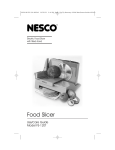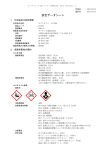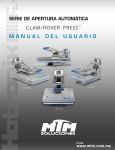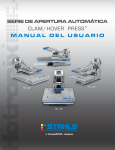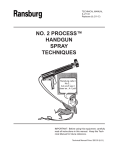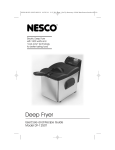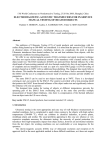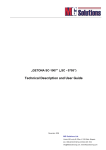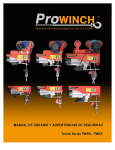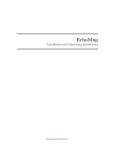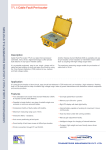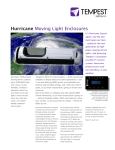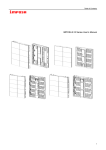Download Delta
Transcript
Thicknessmeter Ultrasonic Defectoscoping Contactless Electromagnetoacoustic УТ-04 ЭМА (Delta) (certificated in Ukraine and Russia) USAGE: Thickness measurement of metalware made from conductive materials with one-side access, corrosion estimation of unapproachable surfaces. APPLICATION: The device can be used in field conditions as well as in workshops and labs of enterprises for residual thickness testing of metalware suffering corrosion. PRINCIPLE OF OPERATION: In the Thicknessmeter electromagnetic-acoustic (EМА) mode of excitation and shear vibrations receiving is used. It allows measuring thickness without contact liquid and surface conditioning, through air gap or nonconducting coating (paint, varnish, enamel, film) about 2 mm thick. DISTINCTIVE FEATURES: Accumulation of echo signals during series of soundings is applied to registration of impaired bottom impulses, increasing signal amplitudes by not less than 25 db, and signal/noise ratio - by 12,5 db. The indicator of the Thicknessmeter shows echogram - sounding and subsequently reflected bottom impulses. This allows using the device as defectoscope, and in thickness metering mode selecting the most distinct pair of bottom impulses for measurement. Material number, item number and up to hundred echograms-screens are stored in the memory. Data can be transmitted to external computer. SPECIFICATIONS: Range of measured metalware thicknesses, mm 1,0 - 200 Limit of thicknessmeter measuring error: in measurement sub-band from 2,0 to 20 mm, mm in measurement sub-band from 20 up to 200 mm, mm ±0,06 ±(0,001Нх + 0,06) Minimum curvature radius of tested surface, mm 10 Size of air gap or nonconducting coating, not exceeding, mm 2,0 Indicator is graphic LCD-display with internal contrast backlighting. Self-contained battery power supply, Volt +12 Time of continuous operation without recharging, not less than, hour 12 Range of operation temperatures, °С from -20 to +60 Weight of the device including power source, not exceeding, kg 2,5 Overall dimensions of electronic unit, mm, sensor, mm, 190х80х205 80х38х38. A mobile handcart for EМА sensor can supplement the device. It allows receiving thickness diagram by wheeling the sensor along the tested item with increase of stored echograms number up to four thousand. UNIT OF EQUIPMENT Description Value Measurement unit (with battery) 1 EMA-sensor 1 Handcart with EMA-sensor 1 Thickness calibration specimen 2 Charging unit 1 PC cable 1 CD with special software 1 User manual 1 Equipment certificate 1 The device is used for thickness measuring of items made from conductive metals with one-sided access. It operates in field conditions and allows making measurements without contact liquid and surface conditioning, through air gap or nonconducting surface. It shows outgoing and echo impulses on the screen, which allows to determine corrosion degree of inaccessible surfaces Comparative tables of efficiency of thickness measurements of metal with electromagneto-acoustic non-contact thickness gauge UT-04-EMA (Delta) and traditional contact ultrasonic thickness gauges Table А. A. Enumeration of obligatory technological operations at thickness measurements with EMA thickness gauge UT-04-EMA (Delta) and traditional contact thickness gauge with piesotransducer. № Description and content of operation А.1. Scraping off rust, scale.. EMA thickness gauge UT-04-EMA (Delta) – not required, if these are not "strata" several and more mm Traditional contact thickness gauge with piesotransducer + always necessary А.2. Scraping off roughness. Scraping off paint layer or removal А.3. of protective coating film. Restoration of paint layer or any А.4. other protective coating. Application-washing away of А.5. contact liquid. thick – not required, if roughness features are below 2mm – not required, if thickness of paint layer or any coating is below 2-3 mm" – only at exceeding 2-3-mm thicknesses, as thinner coatings should not be removed – never required + always necessary + always necessary + always necessary + always necessary Table В. B. Comparison of the factors affecting productivity, cost price, reliability at thickness measurements with electromagneto-acoustic non-contact thickness gauge UT-04-EMA (Delta) and traditional contact ultrasonic thickness gauges with piesotransducer. № В.1. Description and content EMA thickness gauge UT-04-EMA (Delta) Work under any low ambient temperature. - contact liquid is never necessary, no special additional complications caused by low temperature + contact liquid is always necessary, and at low temperatures - only special and very expensive + time for application and removal of contact liquid is always required Work on hot metal, up to +700оС. - contact liquid is never necessary, no special additional complications caused by high temperature. Sometimes cooling of EMA-transducer is desirable + contact liquid is always necessary, and at such high temperatures - special and very expensive + time for application and removal of contact liquid is always required, moreover on such a hot surface + piesoceramics of the transducer behaves badly at high temperatures, thus reliability and reliability of testing is reduced + often piesotransducers are already inoperative at such temperatures without cooling Stratification of metal, which plane is - readily detectable with EMA-thickness measurements, thickness gauge gives also stratification depth and В.2. В.3. Traditional contact thickness gauge with piesotransducer + not detected at all В.4. В.5. В.5.1. В.6. В.7. В.8. perpendicular to direction of wave propagation. thickness of the metal containing such stratification Detecting of stratification of metal, which plane is parallel to direction of wave propagation. a- readily detectable, when stratification plane is perpendicular to oscillations direction of transverse wave of EMA-transducer b-is not detected at 90о turn of EMA- transducer in test point in respect of its position as per item a., i.e. when stratification plane is parallel to a direction of oscillations of a transverse wave of EMA- - transducer – without complications and restrictions Thickness measurement of walls of vessels and pipes filled with liquid. Thickness measurement of walls covered from the inaccessible side with scale or salt deposits Resolution. Possibility to work with a gap several mm wide, without touching with transducer of test surface without contacting the surface Abrasion of transducer of thickness gauge + not detectable + complicated or impossible without special measures - readily performed; only metal thickness is measured + as a rule, total thickness of metal and deposits is measured, or thickness measurement as such is complicated – twice as good as with oscillations induced by contact piesotransducer – always possible, even preferable + half as good as with EMA-thickness gauge UT-04EMA (Delta) + never possible measure through gap, without contact with tested metal – does not occur, as EMA-transducer never gets abraded. Always possible to work with a protector and an air gap + abrasion of piesotransducer is high, it endures some months of continuous operation, not more В.9. В.10. В.10.1. В.11. В.12. В.13. В.14. Time of individual measurement of thickness: a-without account of preparatory operations: scraping, applicationremoval of greasing, restoration of protective coating, orientation of the transducer in the point of testing b- with account of preparatory operations: scraping, applicationremoval of greasing, restoration of protective coating Necessity of additional devices for orientation of the transducer strictly perpendicularly to tested surface in the point of measurements. Necessity of system of feeding of contact liquid with a stationary variant of thickness gauge in a technological stream. Time spent on transducer orientation in test point Test speed while in stream (movement) Availability of echogram on device display screen Presence in device memory Thickness measurement duration is the same –10-100 times less than with thickness gauge with piesotransducer 10-100 longer than with thickness gauge UТ-04EMA – never required + always and obligatorily necessary - never required + always necessary - never required + always obligatory the same – always – always + a very rare service with thickness gauges with piesotransducer + a very rare service В.15. В.16. В.17. of not thickness figure, but rather pulsed echogram Information connection of thickness gauge through mobile communication network and the Internet Volumes of defectoscopic data after 100% of metal thickness measurements Thickness measurement on curvilinear surfaces with small radius of curvature (R ~ several mm) – on order, always + similar devices unknown – substantially lower + are not reduced –thickness measurement is carried out without restrictions with the same transducer at any curvature and without changing the transducer at transition from flat to curvilinear surfaces. + performance of measurements on curved surfaces with "flat" transducer because of insignificant contact of the surface with piesotransducer is impossible, or use of a set of transducers for work on curved surfaces of only one certain radius for each transducer is necessary Table С. C. Materials and equipment input in technological operations of thickness measurement with non-contact thickness gauge UT-04EMA (Delta) and traditional contact ultrasonic thickness gauges with piesotransducer. № Materials and equipment for: С.1. С.5. Scraping off rust, scale, metal roughness Removal-restoration of paint and other surface protective coatings Application-removal of contact liquid Contact liquid proper Expenses on USdefectoscopy after 100% thickness measurements С.6. Expenses on spare transducers for their replacement in case of roundthe-clock operation С.2. С.3. С.4. EMA -thickness gauge UT-04-EMA (Delta) – almost never required Traditional contact thickness gauge with piesotransducer + always necessary + always necessary – only if coating thickness exceeds 2mm –never required + always necessary –never required –Can be reduced several times, as defectoscopy must be carried out in such zones, where defects on EMA thickness gauge display screen are registered, or in places where loss of the emitted by thickness gauge pulses occurs –Zero at correct operation, only casual nonoperations are possible, only because of negligence of the personnel, as abrasive wear of EMA- transducer does not occur + always necessary if ever reduced, but insignificantly + service life of piesotransducer is always finite and is defined by "life time» of its working part which is abraded during the work. Depending on the intensity of operation of the transducer and the degree of roughness of the tested surface, service life can be from several weeks to several months. Thus several pieces of spare transducers are spent in any case. Table D. D. Time input for performance of basic and preparatory operations at thickness measurements with non-contact thickness gauge UT-04-EMA (Delta) and traditional contact ultrasonic thickness gauge with piesotransducer. № Time input for…(Operation description and content) EMA -thickness gauge UT-04-EMA (Delta) Traditional contact thickness gauge with piesotransducer Scraping off roughness of tested surface –necessary only in rare cases when the signal vanishes because of a rough relief of the surface + always necessary Scraping off-restoration –only at thicknesses of paint or other coating exceeding 2mm – never required + always necessary D.1. D.2. of protective paint and other coating Application-removal of D.3. contact liquid Degreasing of surface – never required after contact liquid D.4. removal Correct orientation of the – never required transducer on tested surface strictly D.5. perpendicularly to tested surface. Performance of individual thickness measurement without D.6. taking into account preparatory operations. Defectoscopy after thickness measurement. D.7. Total time of individual D.8. thickness measurement in view of the totality of + always necessary + always necessary + obligatory, from tenths of seconds to several minutes Similar time input – several times less than with thickness measurement using contact piesotransducer + duration and volumes of defectoscopy remain almost not reduced after contact thickness measurement. –10-100 less than with 10-100 longer than with contact thickness gauges EMA-thickness gauges with piesotransducer 9 preparatory works. Repair of transducers. D.9. - Only at a casual or negligent putting the gauge out of operation, regular wear with EMAtransducers does not occur. + regularly and always piesotransducers require periodic renovative repair or replacement 10










